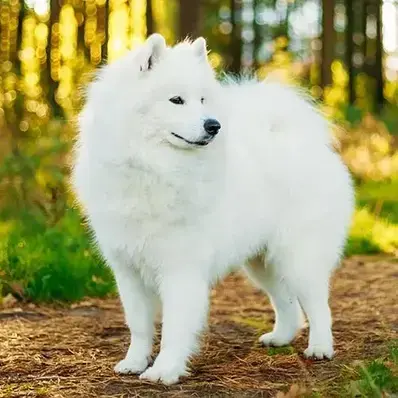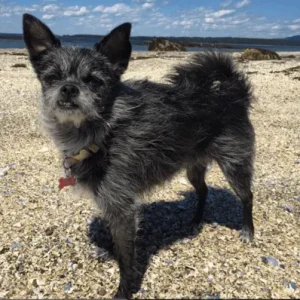Samoyed History/Origin
The hardy and sweet-tempered Samoyed was originally used for hunting, herding reindeer, and pulling sleds for the Siberian Samoyede people. These people treated these purebred dogs kindly and included them in family activities. This fostered a strong sense of trust and loyalty in the breed that persists today.
In the late 19th and early 20th centuries, Samoyeds participated in polar expeditions, including Sir Ernest Shackleton’s Antarctic journey. These dogs endured harsh conditions, with only the strongest surviving.
The first breed standard was adopted in England in 1909. The Samoyed Club of America was organized in 1923, the same year the American breed standard was adopted.
Samoyed History- Source: Icecrwon Samoyed
The name Samoyed comes from the Samoyede people, who migrated to Siberia from Asia a thousand years ago. They bred dogs for hard work in extreme cold, such as in Oymyakon, where temperatures of minus-60 degrees are common.
These people relied on their dogs for warmth, watchdog duties, and hunting reindeer. Eventually, their culture shifted from hunting to herding reindeer, and the dogs adapted to this new role.
In the late 18th century, Arctic adventurers introduced the Samoyed to England. Queen Alexandra promoted the breed as a companion and show dog. In America, Moustan of Argenteau was the first Samoyed registered by the AKC under Working Group in 1906.
Early 20th-century mushers valued Samoyeds for their enthusiasm in hauling supplies, capable of pulling one and a half times their weight. Famous explorers like Scott, Shackleton, and Professor Edgeworth David relied on these dogs during their journeys through frozen wastelands.
Edgeworth David with Samoyed- Source: Icecrwon Samoyed
Samoyed Personality
Samoyed is one of the dog breed that is intelligent, gentle, and loyal dog. Friendly and affectionate with his family, including children, he thrives on being part of household activities.
The Samoyed is not a “lone wolf” dog; he enjoys close association with those he lives with and is mentally and physically unsuited for being left alone in a kennel or backyard. His loyalty and alertness often make for a good watchdog.
- Temperament
Samoyed dogs are renowned for their friendly and affectionate temperament, making them excellent family companions. Known for their perpetual “smile,” which is a result of their upturned mouths, Samoyeds exudes a cheerful and approachable demeanor. They are highly sociable enjoy being around people, including children, and tend to get along well with other pets.
They are also known for their playful and energetic nature, requiring regular exercise to keep them happy and healthy. Their intelligence and eagerness to please make them relatively easy to train, though their independent streak can sometimes present a challenge.
- Potential Issues
At heart, the Samoyed retains strong hunting instincts and may chase small animals he perceives as prey. For safety, always leash him outside his fenced yard. Temperament is influenced by heredity, training, and socialization. Early and varied socialization is crucial for a well-rounded Samoyed puppy.
Inadequate socialization can lead to behavioral issues like shyness or aggression, especially if left alone for long periods. Enroll him in a puppy kindergarten class and expose him regularly to new environments such as parks and dog-friendly stores to develop his social skills and prevent problems.
Samoyed Physical Appearance
The Samoyed is a medium-sized Spitz-type dog characterized by a wedge-shaped head and erect ears. Its mouth corners are slightly upturned, creating a perpetual smile-like expression. The body is slightly longer than it is tall, with well-proportioned and moderately long legs. Its tail is moderately long, bushy with fur, and usually carried over the back, either draped to one side or the other.
- Size
The Samoyed typically stands between 21 to 23 inches tall at the shoulder and weighs between 45 to 65 pounds. Their size and structure also contribute to their agility and endurance in various activities and climates.
- Coat color
The Samoyed’s coat consists of a straight outer layer and a dense, soft undercoat often described as woolly. This breed is typically found in pure white, white with biscuit, cream, or biscuit colorations. These coat variations not only contribute to their aesthetic appeal but also provide insulation and protection from extreme cold, reflecting their Arctic heritage.
Samoyed Gender Differences
- Size
The average height for adult male Samoyeds ranges from 21 to 23.5 inches, with an average weight of 45 to 65 pounds. Adult females typically stand between 19 and 21 inches tall and weigh between 35 and 50 pounds. These size differences between males and females are characteristic of the breed, reflecting their medium-sized stature and sturdy build.
- Temperament
Male Samoyeds make wonderful companions, distinct from females in their slightly higher affection levels, particularly towards children. They tend to be more playful and energetic, often displaying a bolder demeanor, making them excellent watchdogs.
On the other hand, female Samoyeds exhibit a touch more independence while maintaining their affectionate nature. They may show a slight tendency towards being more anxious around children, though this can vary among individuals. Females may prefer activities like working or exercising over playtime, making them ideal companions for outdoor enthusiasts and hikers.
Samoyed Feed/Nutrition
Feed your adult Samoyed 1.5 to 2.5 cups of high-quality dry food daily, split into two meals. The amount should be adjusted based on your dog’s size, age, metabolism, and activity level. For puppies, ensure slow, steady growth with a diet containing 22 to 24 percent protein and 12 to 15 percent fat.
Maintain your Samoyed’s health by measuring his food and feeding him twice daily rather than free-feeding. To monitor weight, use the eye test to ensure a visible waist and the hands-on test. Blueberries are a great treat option, providing antioxidants and fiber, but be sure to feed them in moderation.
Samoyed Health
Samoyeds are generally healthy, but like all breeds, they are prone to certain health conditions. Not all Samoyeds will get these diseases, but it’s important to be aware of them if you’re considering this breed.
- Glaucoma: Defined by increased pressure in the eye, glaucoma can be primary (hereditary) or secondary (caused by other eye diseases). Symptoms include vision loss and pain. Treatment varies and may include surgery or eye drops.
- Hip Dysplasia: An inherited condition where the thighbone doesn’t fit snugly into the hip joint, causing pain and lameness in some dogs. Diagnosis is confirmed through X-ray. Arthritis can develop as the dog ages. Dogs with hip dysplasia should not be bred; ensure the breeder provides proof of hip dysplasia testing.
- Samoyed Hereditary Glomerulopathy: A genetic kidney failure disease more severe in males, who appear healthy for the first three months but typically die from renal failure by 15 months. Females develop mild symptoms but do not suffer renal failure. No genetic screening test is currently available, but research is ongoing.
- Patellar Luxation: Known as slipped stifles, this condition involves the dislocation of the kneecap, causing pain and potentially leading to a relatively normal life despite the condition.
- Hypothyroidism: A thyroid gland disorder that can cause epilepsy, hair loss, obesity, lethargy, hyperpigmentation, and skin conditions. It is treated with medication and diet.
- Diabetes: A disorder where the body cannot regulate blood sugar levels, leading to excessive urination, thirst, increased appetite, and weight loss. It is controlled by diet and insulin administration.
- Progressive Retinal Atrophy: A family of eye diseases involving the gradual deterioration of the retina, leading to night blindness and, eventually, total blindness. Affected dogs adapt well as long as their surroundings remain consistent.
- Subvalvular Aortic Stenosis: A heart problem caused by a narrow connection between the left ventricle and the aorta, potentially causing fainting and sudden death. Consult your vet for detection and treatment options.
- Syringomyelia (SM): A chronic condition affecting the spinal cord, where fluid-filled cavities form within the central canal, causing pain and partial paralysis. Though common in toy breeds, it can affect any dog.
Samoyed Care and Grooming
The Samoyed sheds heavily, making maintenance quite demanding. Daily brushing is necessary during shedding periods, and once or twice a week otherwise.
Bathing about every eight weeks, or whenever he gets particularly dirty, is also important. Bathing is time-consuming due to the need for thorough soaking, rinsing, and drying of the coat. Many owners prefer to hire a professional groomer, which, while expensive, eases the burden. Regular brushing is still required even if you use a groomer.
Exercise-wise, Samoyeds are active and need daily physical activity. Aim for at least an hour of exercise to keep them healthy and happy. Regular walks, playtime, and mental stimulation are key to keeping your Samoyed fit and content.
Get your dog used to grooming and handling from a young age. Frequently touch his paws and look inside his mouth. Make grooming a positive experience with praise and rewards to ease future vet visits and handling.
During grooming, check for sores, rashes, or signs of infection like redness, tenderness, or inflammation. Ensure his eyes are clear without redness or discharge. Regular, careful exams can help you spot potential health problems early. Training your dog to stop barking will help maintain peace at home and reinforce positive behavior.
Samoyed Rescue Groups
Rescue groups dedicated to Samoyeds work tirelessly to provide these dogs with loving, permanent homes. These animal shelters focus on rescuing, rehabilitating, and rehoming dogs that have been abandoned, neglected, or surrendered. By adopting from a rescue group, you not only give a dog a second chance but also support efforts to promote responsible pet ownership.
Samoyed Price
The price of a Samoyed typically ranges from $1,500 to $3,000, depending on factors such as breeder reputation, pedigree, and location.
When purchasing a Samoyed, it’s essential to find a reputable breeder who prioritizes the health and well-being of their dogs. Look for breeders who provide health clearances, proper care, and socialization for their puppies.
Interesting Facts
- Social, intelligent, and loyal, Samoyeds are known for their distinctive “Samoyed smile.” Their upwardly curling lips prevent drool from freezing in cold weather.
- It takes a skilled owner to bring out the best in these intelligent dogs, as they get bored easily. They have earned MACH titles in agility, and high-in-trial awards in obedience, and have even outperformed traditional herding breeds in herding trials.
MACH titles- Source: AKC.org
- In “The Secret Life of Pets 2” – Gidget, one of the main characters, is a white fluffy dog modeled after the Samoyed breed.
The Secret Life of Pets 2- Source: IMDb
Best For
Samoyeds are best for active individuals or families willing to dedicate time to regular grooming and early socialization. They thrive on companionship, but their vocal nature should be considered, as they are expressive barkers.
Top Names
| Male Samoyed Names | Female Samoyed Names |
| Max | Bella |
| Bear | Luna |
| Duke | Daisy |
| Finn | Zoey |
| Thor | Willow |









 Samoyed History- Source:
Samoyed History- Source:  Edgeworth David with Samoyed- Source:
Edgeworth David with Samoyed- Source: 

 Pure White Samoyed- Source:
Pure White Samoyed- Source:  White with Biscuit Samoyed- Source:
White with Biscuit Samoyed- Source: 
 MACH titles- Source:
MACH titles- Source:  The Secret Life of Pets 2- Source:
The Secret Life of Pets 2- Source: 






